AMD’s Radeon HD 5850: The Other Shoe Drops
by Ryan Smith on September 30, 2009 12:00 AM EST- Posted in
- GPUs
Power, Temperature, & Noise
With Cypress pared down some for the 5850, the power/temperature/noise situation takes on a different look. The 5870 ended up being hot, noisy, and more power-hungry than any other single-GPU setup under load. Let’s see if the 5850 can avoid that.
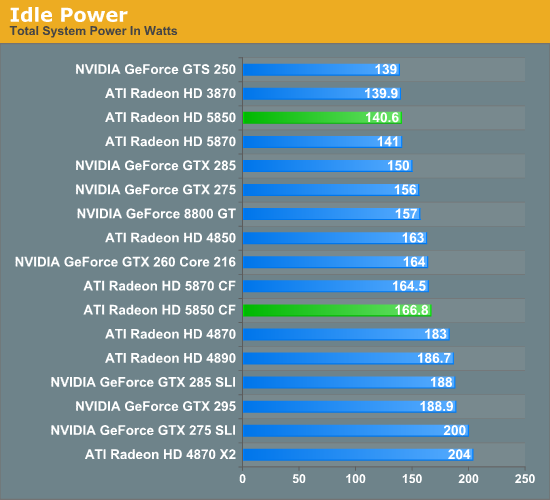
Looking at idle power, the results are the same as the 5870. This is to be expected as both are capable of reaching the same low idle power state. Crossfire results are similar, although the 5850 CF nudges itself higher than the 5870 CF on our charts; but this is within experimental variance.
As was the case with the 5870, the 5850 is among the lowest idling cards we have seen. It’s at the very bottom, only the Radeon HD 3870 and the GeForce GTS 250 can beat it, and even then just by a watt and a half.
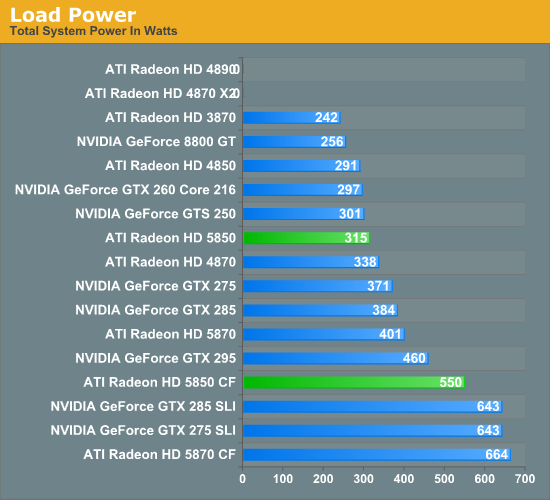
Load power on the other hand gives us a surprising difference. While the 5870 was one of the most power-hungry single-GPU cards we tested, the 5850 moves half-way down the chart. At load it uses less power than 4870 and most of the GTX series, in effect using less power than all of its closest performance competitors. In fact the difference in load power is beyond the specs; AMD’s specs call for a 37W difference, but here we have an 86W difference. Even after accounting for power supply inefficiencies, this is still a huge difference. We’re not seeing clock throttling occurring, so at this point we don’t have a complete explanation for what we’re seeing beyond the fact that we’re sure these are legitimate results.
The end result is that it’s clear that the 5850 is going to work well in systems with limited power abilities. At the same power envelope it’s significantly faster than anything else, and at the same performance level it’s significantly less power hungry than anything else.
As for Crossfire, this gap closes somewhat in that configuration. Here it’s only 114W under the 5870 CF, and just 93W under the GTX SLI cards. Even with its low power usage, the 5850 can’t erase the fact that multi-card solutions eat much more power than single-card solutions; it’s 90W over the GTX295, for example.
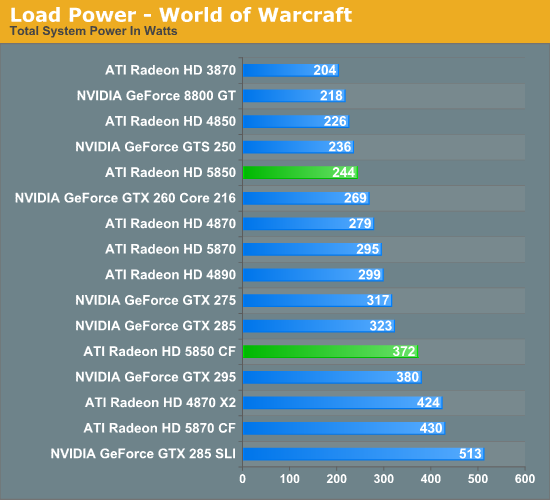
We’ll also take a look at power usage in Warcraft quickly, since it doesn’t trigger throttling in our other AMD cards. Warcraft doesn’t push these cards like OCCT does, so the overall power usage is lower, but the overall situation is virtually the same. The 5850 comes in at 55W less than the 5870, and this time bests the entire GTX lineup by at least 25W. We also see Crossfire do better here; now the 5850 CF can beat even multi-GPU cards like the 4870X2 and the GTX 295.
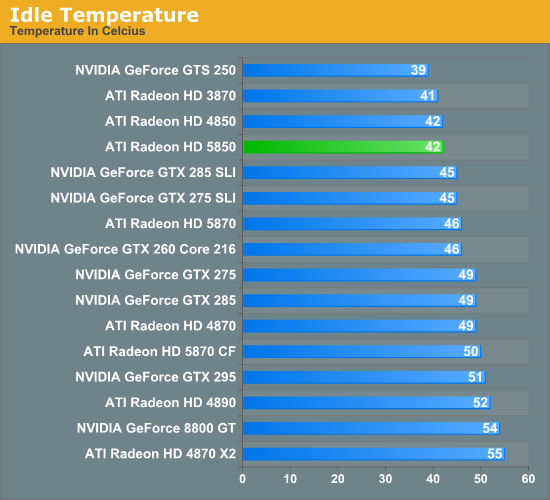
Interestingly enough, in spite of the same idle power as the 5870, the idle temps are not the same. The 5850 comes in at a chilly 42C, bringing it in line with the 4850 and the 3870. Only the GTS 250 can beat it by 3C, and in turn the 5850 beats its closest competitors, the GTX series, by at least 3C.
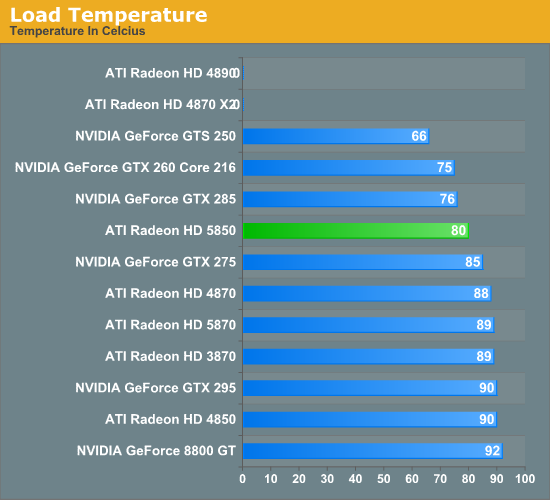
With lower power usage and a similar cooler, the 5850 is capable of keeping cooler than the 5870. While the 5870 approached 90C, the 5850 we’re testing was able to stay at 80C. This makes it the only AMD card we’ve tested that isn’t approaching 90C, which is good news for those of you with limited case ventilation. However it still loses to the GTS 250, and most of the GTX cards. We know NVIDIA is consuming more power, so clearly they have a more effective cooler in use if it’s able to cool their cards that well.
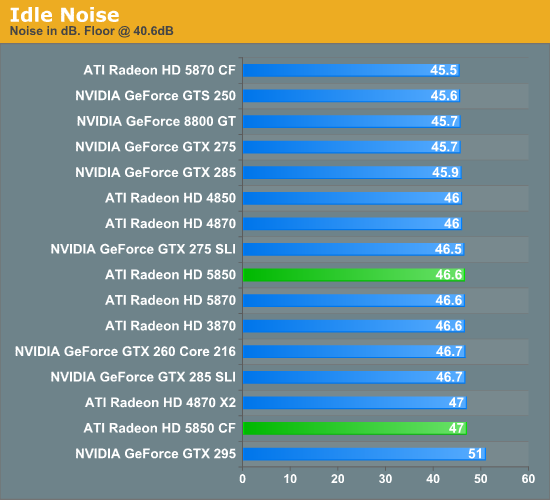
Finally we have noise. At idle virtually everything is the same, the 5850 and the 5870 come in at 46.6dB. To see a significant difference here, we would have to switch to a passively-cooled card.
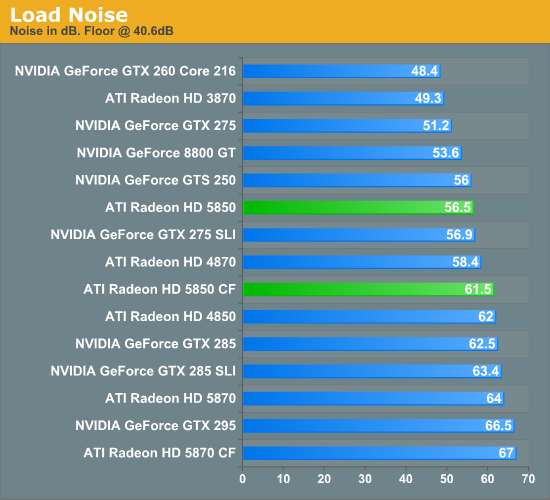
At load, the 5850 is just below the middle of the pack. Thankfully it’s not nearly as loud as the 5870, shaving off 8dB compared to its big brother and brings a Cypress-based card in to more reasonable territory. Adding a second card for Crossfire makes things louder at 61dB, but even that is still 6dB quieter than the 5870 CF.
This also shows us the tradeoffs NVIDIA made in cooling compared to AMD. The GTX 285, which was cooler running, is 6dB louder here as a result. Going by our charts the 5850 is fairly balanced in noise and temperature; it’s doesn’t need to make any trade-offs to achieve one or the other.










95 Comments
View All Comments
Ryan Smith - Wednesday, September 30, 2009 - link
An excellent question! This isn't something we had a chance to put in the article, but I'm working on something else for later this week to take a look at exactly that. The 5850 gives us more of an ability to test that, since Overdrive isn't capped as low on a percentage basis.Zool - Wednesday, September 30, 2009 - link
You could make some raw shader tests that doesnt depend on memory bandwith to see if the gpu internal bandwith is somehow limited or the external bandwith. And maybe try out some older games(quake3 or 3dmark2001).In DX11 games will use more shader power for other things which hawe litle impact on bandwith. Maybe they tested those heawy dx11 scenarios and ended with much less costly 256bit interface as a compromis.
Dante80 - Wednesday, September 30, 2009 - link
Up to 80watts lower consumption in load120$ less
Quieter
Cooler
Shorter
Performance hit around 10-15% against 5870 (that means far better perf/watt and perf/$)
~12% More performance than GT285
Overclocks to 5870 perf easily
Ok, this is an absolute killer for the lower performance market segment. Its 4870vs4850 all over again. Only this time, they get the performance crown for single cards too.
Another thing to remember, is that nvidia does not currently have a countermeasure for this card. The GT380 will be priced for the enthusiast segment, and we can only hope for the architecture to be flexible enough to provide a 360 for the upper performance segment without killing profits due to diesize constraints. Things will get even more messy as soon as Juniper lands, the greens have to act now (thats our interest as consumers too)! And I don't think that GT200 respins will cut it.
the zorro - Wednesday, September 30, 2009 - link
maybe if intel heavily overclocks a gma 4500 can can compete with amd?haplo602 - Wednesday, September 30, 2009 - link
hmm ... my next system shoudl feature a GTS 250. Unless ATI releases a 5670 and finaly hits opengl 3.2 and opencl support in their linux drivers.anyway the 5850 will kill lot of Nvidia cards.
san1s - Wednesday, September 30, 2009 - link
interesting results, can't wait to see how gt300 will comparepalladium - Thursday, October 1, 2009 - link
"interesting results, can't wait to see how gt300 will compare "SiliconDoc: WTF?! 5870< GTX295, top end GT300>>295 because it has 384bit GDDR5 ( 5870 only 256 bit), so naturally GT300 will KICK RV8xx's A**!!!!
That's my prediction anyway (hopefully he decides not to troll here)
Dobs - Wednesday, September 30, 2009 - link
My guess is - GT300 wont compare to 5850 or 5870.It will compare with the 5870X2 and be in the price bracket. (Too much for most of us.)
When the GT300 eventually gets released that is.... Then a few months later again nvidia will bring out the scaled down versions in the same price brackets as the 5850/5870 that will probably compete pretty well.
Only question is - can you wait?
You could wait for the 6870 as well:P
Vinas - Wednesday, September 30, 2009 - link
No, I don't have to wait because I have a 5870 :-)The0ne - Wednesday, September 30, 2009 - link
I really think enthusiast that spends hundreds on the MB alone isn't the regular enthusiast. So price wouldn't be an issue. I love building PCs and testing them but I'm not going to spend $200+ of a MB knowing that I will be building another system in few months with better performance parts and pricing. Unless I'm really keeping the system for a long time then I'll pour my hard earn money into the high end parts. But then if you're doing this I don't think you're really an enthusiast as it's really a one shot deal?